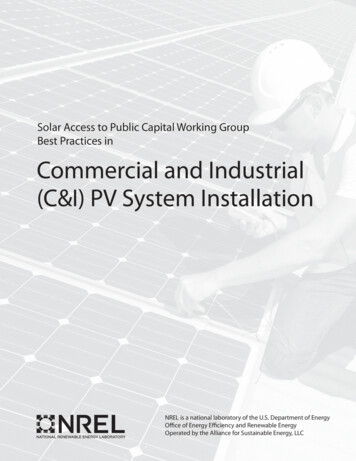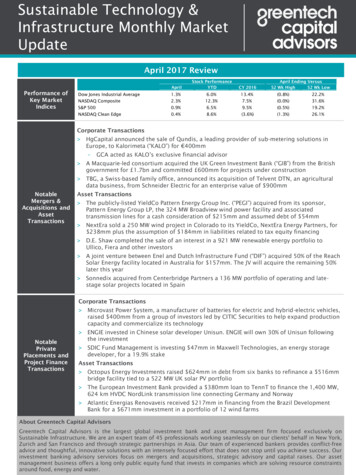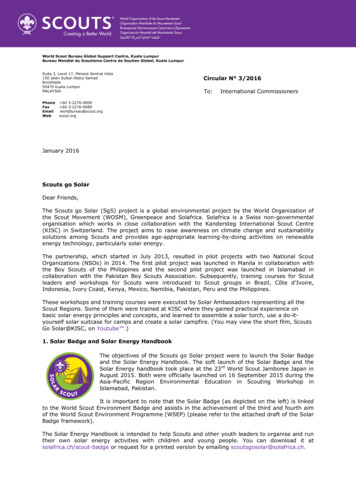
Transcription
Solar Access to Public Capital Working GroupBest Practices inCommercial and Industrial(C&I) PV System InstallationNREL is a national laboratory of the U.S. Department of EnergyOffice of Energy Efficiency and Renewable EnergyOperated by the Alliance for Sustainable Energy, LLC
Best Practices in Commercial andIndustrial (C&I) Solar PhotovoltaicSystem InstallationPeriod of PerformanceNovember 28, 2014–September 1, 2015Chris DoyleDividend Solar, IBTSLen Loomans, Andrew Truitt, and Robert LockhartAcuity PowerMatt GoldenEfficiency.orgKareem DabbaghAurora SolarRichard LawrenceNABCEPNREL Technical Monitors: Michael Mendelsohn and FranciscoFlores-EspinoNREL is a national laboratory of the U.S. Department of EnergyOffice of Energy Efficiency & Renewable EnergyOperated by the Alliance for Sustainable Energy, LLCThis report is available at no cost from the National Renewable EnergyLaboratory (NREL) at www.nrel.gov/publications.Subcontract ReportNREL/SR-6A20-65286December 2015Contract No. DE-AC36-08GO28308
This publication was reproduced from the best available copysubmitted by the subcontractor and received minimal editorial review at NREL.NOTICEThis report was prepared as an account of work sponsored by an agency of the United States government.Neither the United States government nor any agency thereof, nor any of their employees, makes any warranty,express or implied, or assumes any legal liability or responsibility for the accuracy, completeness, or usefulness ofany information, apparatus, product, or process disclosed, or represents that its use would not infringe privatelyowned rights. Reference herein to any specific commercial product, process, or service by trade name,trademark, manufacturer, or otherwise does not necessarily constitute or imply its endorsement, recommendation,or favoring by the United States government or any agency thereof. The views and opinions of authorsexpressed herein do not necessarily state or reflect those of the United States government or any agency thereof.This report is available at no cost from the National Renewable EnergyLaboratory (NREL) at www.nrel.gov/publications.Available electronically at SciTech Connect http:/www.osti.gov/scitechAvailable for a processing fee to U.S. Department of Energyand its contractors, in paper, from:U.S. Department of EnergyOffice of Scientific and Technical InformationP.O. Box 62Oak Ridge, TN 37831-0062OSTI http://www.osti.govPhone: 865.576.8401Fax: 865.576.5728Email: reports@osti.govAvailable for sale to the public, in paper, from:U.S. Department of CommerceNational Technical Information Service5301 Shawnee RoadAlexandria, VA 22312NTIS http://www.ntis.govPhone: 800.553.6847 or 703.605.6000Fax: 703.605.6900Email: orders@ntis.govCover Photo: iStock 46445820NREL prints on paper that contains recycled content.
DisclaimerThe attached Best Practices in Commercial and Industrial (C&I) Photovoltaic (PV) SystemInstallation Guide was developed through an industry-organizing process convened by theNational Renewable Energy Laboratory (NREL). The process was open to a wide array ofindustry members to get a broad range of perspectives. The document represents the result oflong discussions and negotiations on a variety of topic areas of interest to the participatingstakeholders. The document does not reflect NREL’s or the U.S. Department of Energy’sendorsement of any activity or group of activities. Rather, the document is designed to provide areasonable protocol associated with photovoltaics (PV) system installation supported by theindustry stakeholder process in order to mitigate risks and improve PV asset energy and cashflow production reliability.iiiThis report is available at no cost from the National Renewable Energy Laboratory (NREL) at www.nrel.gov/publications.
AcknowledgmentsThe authors would like to thank the following contributors to this report.ContributorsCalder Lamb, Dominion Energy SolutionsMinh Le, U.S. Department of EnergyKimberlie Lenihan, New York State EnergyResearch and Development AuthorityJay Levin, Clean Energy AssociatesJohn Lochner, Locus EnergyRich Matsui, kWh AnalyticsMichael Mendelsohn, NRELJack Meng, Fortune EnergyDavid Milner, NuGen Capital, DividendSolarEmeline Minor, Kilowatt FinancialRue Phillips, TRUE South Renewables Inc.Travis Richardson, SungevitySydney Roberts, SouthfaceMehrad Saidi, SunSystem TechnologyLaks Sampath, NRG Energy, Inc.Jeffrey Schub, Coalition for Green CapitalGreg Sellers, Clean Power FinanceAashish Shahani, IBTSShawn Shaw, CadmusJosh Sturtevant, Distributed SunDon Warfield, NABCEPScott Weicht, Adolfson and PetersonChase Weir, Distributed SunRoger Williams, SungevityPeter Xu, PVAP Expo 2012Johan Alfsen, Quick Mount PVMark Berger, NextGrid TechnologiesMegan Birney, Wiser CapitalBrian Brookman, Solar Energy IndustriesAssociationJoe Cain, DNV GLDerek Chase, SunSystem TechnologyJohn Dalton, Burnham EnergyLyleen Dauz, Burnham EnergyMatt Denninger, Advanced EnergyIndustriesCJ Desantis, CounterPointe EnergySolutionsPaul Detering, Redwood InsightsTrevor D’Olier-Lees, Standard & Poor’sMax Foltz, TRUE SouthWhit Fulton, Infinite InventionHeath Galoway, SungevityDavid Hattis, Building Technology, Inc.C. Todd Himle, Super Anchor SafetyRon Hooson, Solar Inspectors HawaiiDavid Inda, Clean Power FinanceSaul Inda, GAF SolarDrew Johnson, Burnham EnergyNick Kasza, Distributed SunTJ Keating, SunSpec AllianceGeoff Klise, Sandia National LaboratoriesSarah Kurtz, NRELivThis report is available at no cost from the National Renewable Energy Laboratory (NREL) at www.nrel.gov/publications.
List of ting currentauthority having jurisdictionAmerican Society of Civil Engineersapplication programming interfacebalance of systemcommercial and industrialcommissioning authoritycommercial general liability (insurance)commissioningdirect currentelectrical contractorequipment groundingerrors and omissions (insurance)engineer of recordengineering, procurement, and constructionElectric Power Research Institutefield inspection verificationground fault detection and interruptionground fault protectionInstitute for Building Technology and Safetycurrent-voltage (curve)International Code CouncilInternational Electrotechnical CommissionInternational Fire CodeIngress Protection (rating)Interstate Renewable Energy CouncilInternational Organization for Standardizationjob hazard analysislightning protection systemmaximum foreseeable lossmegawattNorth American Board of Certified EnergyPractitionersNational Electrical Manufacturers AssociationNational Electrical CodeNorth American Electric Reliability Corporationnormal loss expectedoperations and maintenanceowner’s engineerOccupational Safety and Health Administrationprofessional engineerpotential-induced degradationprobably maximum losspower purchase agreementpersonal protective equipmentvThis report is available at no cost from the National Renewable Energy Laboratory (NREL) at www.nrel.gov/publications.
y assurancequality controlresidual current deviceSolar Access to Public Capitaltotal case incident ratetime-of-use (rates)third-party owned systemtotal solar resource fractionUL was formerly known as UnderwritersLaboratoriesultravioletvoltviThis report is available at no cost from the National Renewable Energy Laboratory (NREL) at www.nrel.gov/publications.
Table of Contents12Introduction . 11.11.21.31.41.5Qualifications . 42.12.23Solar Access to Public Capital . 1Purpose . 1How to Use This Document . 2Guide Overview . 2Definition of Roles . 21.5.1 Owner . 21.5.2 Developer . 21.5.3 EPC Contractor . 22.32.42.5EPC Contractor General Qualifications . 42.1.1 Trade Licenses. 42.1.2 Work History . 42.1.3 Financial Solvency . 42.1.4 Health and Safety . 42.1.5 Insurance . 52.1.6 EPC Bonding Capacity (Performance Security) . 62.1.7 EPC Engineer Insurance. 62.1.8 Defined Quality Management Plan . 6EPC Contractor Personnel Qualifications . 72.2.1 EPC Engineer Qualifications . 72.2.2 EPC Project Manager Qualifications . 72.2.3 EPC Installer Site Supervisor Qualifications . 8Operator/O&M Provider Qualifications . 8Engineer of Record Qualifications . 8Developer Qualifications. 9Project Design Best Practices. 103.13.23.33.43.5Usage Data and Estimate of Utility Cost Savings . 10Site Data . 113.2.1 Site Information. 113.2.2 Structural Information . 113.2.3 Roof Information (if applicable) . 113.2.4 Electrical Information . 123.2.5 Potential Locations for New Equipment . 13Production Estimate . 133.3.1 Estimating Tools . 133.3.2 Modeling Tools . 133.3.3 Solar Resource/Weather Data Sources . 143.3.4 Performance Guarantees . 14System Design . 143.4.1 Project Planset . 153.4.2 Module Support Structure . 163.4.3 DC System Design . 173.4.4 AC System Design . 17Equipment Requirements . 173.5.1 Photovoltaic Modules. 173.5.2 Inverters. 183.5.3 Racking Systems . 183.5.4 Monitoring. 19viiThis report is available at no cost from the National Renewable Energy Laboratory (NREL) at www.nrel.gov/publications.
43.6Installation Best Practices . 204.14.5Equipment Best Practices . 204.1.1 PV Modules . 204.1.2 Mounting Systems . 20Workmanship Best Practices . 214.2.1 System Grounding and Bonding . 214.2.2 DC Ground-Fault Protection (DCGFP). 224.2.3 DC Arc-Fault Circuit Protection (DCAFP) . 224.2.4 Rapid Shutdown of PV Systems on Buildings . 224.2.5 Marking (Labeling) Best Practices . 224.2.6 Mechanical Components . 234.2.7 Systems with Module-Level Power Electronics . 23System Documentation . 244.3.1 Required Site Data Points . 244.3.2 Required System Design Data. 244.3.3 As-Built Photograph Inventory . 254.3.4 EPC Submittal Information . 25Third-Party Inspection and Verification. 264.4.1 Field Inspection Verification . 264.4.2 Third-Party Inspector Qualifications . 274.4.3 Scoring System. 27Interconnection . 285.15.25.3Solar PV Operations, Maintenance, and Monitoring (OM&M). 30PV System Warranty . 31Solar PV System Commissioning . 314.24.34.453.5.5 Electrical Components . 19Permitting and Inspections . 19O&M Best Practices . 306 References and Resources . 33Appendix. References to Codes, Standards, and Guidelines . 36viiiThis report is available at no cost from the National Renewable Energy Laboratory (NREL) at www.nrel.gov/publications.
1 Introduction1.1 Solar Access to Public CapitalThe following Best Practices in Commercial and Industrial (C&I) PV System Installation Guideis one of several work products developed by the Solar Access to Public Capital (SAPC)working group. SAPC worked from 2012 to 2015 to open capital market investment for PVsystems. Capital market investment includes debt and equity securities procured by pensionfunds, family offices, endowment funds, and other large managers of investment. These sourcesof institutional investments allow for the industry to access the lowest cost of capital financing.SAPC membership included over 480 leading solar developers, financiers and capital managers,law firms, rating agencies, accounting and engineering firms, and other stakeholders engaged insolar asset deployment. 1 SAPC activities were directed toward foundational elements necessaryto pool project cash flows into tradable securities: Standardization of power purchase, lease and loan contracts for residential andcommercial end customers Development of performance and credit data sets to facilitate investor due diligenceactivities Engagement of rating agencies to comprehend their risk perception of the solarasset class Development of best practice documents for photovoltaic (PV) system installation andoperations and maintenance (O&M) protocols to encourage high-quality systemdeployment and operation that may improve lifetime project performance andenergy production.1.2 PurposeThis Best Practices in C&I PV System Installation Guide is the second of a series of guidesdesigned to standardize and improve solar asset transparency for investors and rating agencies,provide an industry framework for quality management, and reduce transaction costs in the solarasset securitization process. The Best Practices in C&I PV System Installation Guide is intendedto outline the minimum requirements for commercial and industrial solar project developments.Adherence to the guide is voluntary. Providers that adhere to the guide are responsible for selfcertifying that they have fulfilled the guide requirements. Investors and rating agencies shouldverify compliance.The first in the series, SAPC Best Practices in PV System Installation, was published in March2015 and addresses best practices in the installation of residential PV systems (Doyle etal. 2015).SAPC was funded by the U.S. Department of Energy during a three-year period that concluded onSeptember 30, 2015.11This report is available at no cost from the National Renewable Energy Laboratory (NREL) at www.nrel.gov/publications.
1.3 How to Use This DocumentThis document is best viewed on a computer or tablet in order to take full advantage of theembedded, clickable hyperlinks that lead to further information and additional resources. Eachhyperlink is fully cited in section 6, References and Resources. Relevant definitions used in thisdocument are listed in the Appendix.1.4 Guide OverviewThere is no one-size-fits-all solar deployment strategy. Firms have unique value propositions,customer acquisition strategies, distribution channels, and technical specifications. Theframework for the guide includes:1. Developer qualifications2. Engineering, procurement, and construction (EPC) qualifications3. Design best practices4. Installation best practices5. O&M/Operator best practices.1.5 Definition of Roles1.5.1 OwnerIn the C&I PV sector, development of third-party-owned (TPO) systems typically includes aturnkey solar energy supply agreement for a host client, also known as the energy off-taker. The“Owner” is identified as the long-term owner of the project, and may typically be a specialpurpose entity comprised of the Developer, the Investor, or both.1.5.2 DeveloperThe Developer is responsible for facilitating the planning and construction of the PV project,including site selection, design, solar resource and energy production estimation, permits, utilityinterconnection, construction, and commissioning. The Developer might only act as an originatoror project broker and not play an active role once the project construction commences.The primary objective of the Developer is to create financeable PV projects with soundinvestment return and performance upside. Developers have found success in third-party leasingand power purchase agreement (PPA) models, backed with traditional sources of debt and equityfinancing. As the financing landscape evolves, these third-party ownership models are strongcandidates for new sources of financing such as asset securitization.Investors seek diversification of underlying assets, as well as predictable and profitableoperations, low credit risk, and project transparency.1.5.3 Engineering, Procurement, and Construction ContractorThe Developer or Owner typically contracts with a primary entity known as an engineering,procurement, and construction (EPC) Contractor for turnkey EPC services. The EPC Contractormay use internal design and construction resources, or may subcontract some of these services;for example, the EPC Contractor may subcontract installation to an electrical contractor (EC).2This report is available at no cost from the National Renewable Energy Laboratory (NREL) at www.nrel.gov/publications.
The EPC Contractor can have an important impact on the quality of the asset in terms of systemsafety, performance, and durability. As such, the legal agreement between the Developer orOwner and the EPC Contractor is a critical component of project risk for investors.3This report is available at no cost from the National Renewable Energy Laboratory (NREL) at www.nrel.gov/publications.
2 Qualifications2.1 EPC Contractor General QualificationsThe EPC Contractor’s performance and financial capabilities to successfully complete itsobligations under contract are of key importance. The EPC Contractor should meet minimumgeneral requirements and minimum personnel qualifications as set forth below.2.1.1 Trade LicensesThe EPC Contractor should have all professional and trade licenses required by the applicablestate and local authorities having jurisdiction (AHJ). Required solar PV licenses can be foundthrough the Interstate Renewable Energy Council’s (IREC) Solar Licensing Database(IREC 2014).2.1.2 Work HistoryThe EPC Contractor should have a successful track record of design and construction of similartype and scale projects, completed on time and on budget. The EPC Contractor shoulddemonstrate this experience through: At least 3 years company work experience in design, engineering and installation ofcommercial scale solar PV systems2.1.3 Financial SolvencyThe EPC Contractor should have the financial resources to successfully complete projects and tomeet all warranty obligations. EPC Contractors shall provide documentation related to thefinancial solvency of the company. The documents should be kept on file by the financingcompany. Sample documents include: Audited financial statementsBank referencesSupplier referencesThe purpose of these references is to demonstrate that the EPC Contractor is/was not in financialdistress at the time of project development and installation. Financial distress could have anegative impact on the level of system quality.2.1.4 Health and SafetyThe EPC Contractor should have and maintain a health and safety manual that establishesappropriate rules and procedures concerning workplace safety, including rules related to:reporting health and safety problems, injuries, and unsafe conditions; risk assessment; and firstaid and emergency response.Some examples of typical rules and procedures include: Contractor Site Supervisor has completed a minimum of Occupational Safety and HealthAdministration (OSHA) 30-hour Construction Industry training, and all site personnelhave completed a minimum of OSHA 10-hour Construction Industry training.4This report is available at no cost from the National Renewable Energy Laboratory (NREL) at www.nrel.gov/publications.
Additional training should be supplemented to provide sufficient knowledge for installersto identify hazards, provide corrective actions, and prevent reoccurrence specific to solarPV systems. All site personnel must be equipped with complete personal protective equipment (PPE)and trained on any specific hazards associated with their jobs. Contractor Site Supervisor has completed a job hazard analysis (JHA). Contractor Site Supervisor has completed a job site orientation with all workers onsite.The Contractor must maintain an OSHA total case incident rate (TCIR) of 5.00 or less or asimilar rate based on a substantially equivalent, accepted measure used to reportworkplace injuries.2.1.5 InsuranceAn EPC Contractor must maintain appropriate levels of insurance relative to project scale,complexity, and associated risk. An insurance engineer and underwriter should be engaged toevaluate a design or installation and to negotiate the following parameters: normal loss expected(NLE), which determines the dollar amount of the deductible without an insurance claim;probable maximum loss (PML), which determines the premium paid on a policy; and maximumforeseeable loss (MFL), which sets limits on coverage. Coverage should include: Commercial general liability (CGL) insurance ( 1,000,000 per occurrence, 2,000,000aggregate) CGL umbrella policy Commercial vehicle insurance ( 1,000,000 per occurrence) Inland marine insurance, which insures against loss of equipment not on theproperty premises Insurance policies should name the developer or owner and any intermediaries asadditional insured(s) and certificate holder(s). Legal agreements between theDeveloper/Owner and EPC Contractor should require additional insured specification.Professional liability insurance, also known as errors and omissions (E&O) insuranceProperty insurance (builder’s risk), written on an “all-risks” structure and replacementcost basis; alternatively, this may be covered under the Developer’s coverage, dependingon the specific arrangement between partiesWorkers compensation insurance ( 1,000,000 each accident, each employee)Business interruption insurance, which covers lost revenue due to downtime caused bycovered event5This report is available at no cost from the National Renewable Energy Laboratory (NREL) at www.nrel.gov/publications.
2.1.6 EPC Bonding Capacity (Performance Security)Surety BondsSurety bonds, or performance bonds, are typically provided by an insurance company (surety orguarantor) to back the performance of the EPC Contractor and ensure that the constructionproject is completed even if the EPC contractor goes bankrupt. Surety bonds are a means toprotect the contract counterparty, in this case the Developer, if the EPC Contractor is unable tofulfill its contractual requirements.Payment BondsPayment bonds are insurance that ensures that subcontractors get paid even if the EPC contractorgoes bankrupt, and thus there are no mechanic’s liens against the facility upon completion.2.1.7 EPC Engineer InsuranceInsurance requirements for project engineers should be relative to the scale and scope of theproject, but should include at least: Professional liability (E&O) insuranceCommercial general liability insuranceCommercial vehicle insuranceWorkers compensation insuranceInsurance policies should name the Developer/Owner and any intermediaries asadditional insured(s) and certificate holder(s).2.1.8 Defined Quality Management PlanThe EPC Contractor shall have a quality management plan that includes all elements of thecompany’s customer service policy and other quality assurance practices. The plan should bedistributed to all company employees and contain a Quality Manual, as defined by InternationalOrganization f
NERC North American Electric Reliability Corporation . NLE normal loss expected . O&M operations and maintenance . OE owner's engineer . OSHA Occupational Safety and Health Administration . P.E. professional engineer . PID potential-induced degradation . PML probably maximum loss . PPA power purchase agreement . PPE personal protective equipment











